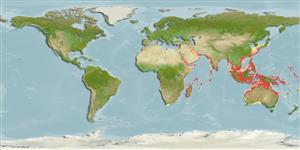Common names from other countries
>
Gobiiformes (Gobies) >
Gobiidae (Gobies) > Gobionellinae
Etymology: Oxyurichthys: Greek, oxys = sharpen + Greek, oura = tail + Greek, ichthys = fish (Ref. 45335).
More on author: Bleeker.
Environment: milieu / climate zone / depth range / distribution range
Ecologia
marinhas; estuarina demersal; anfídromo (Ref. 51243); intervalo de profundidade ? - 75 m (Ref. 2798). Tropical
Indo-West Pacific: Kenya to Transkei, South Africa; eastward to the tropical western Pacific (Ref. 4343). Known from the Mekong delta and may penetrate up the tidal zone as far as Cambodia (Ref. 12693).
Tamanho / Peso / Idade
Maturity: Lm ? range ? - ? cm
Max length : 15.2 cm TL macho/indeterminado; (Ref. 126015); peso máx. publicado: 14.55 g (Ref. 126015)
Descrição suscinta
Chaves de identificação | Morfologia | Morfometria
Espinhos dorsais (total) : 7; Raios dorsais (total) : 12 - 13; Espinhos anais: 1; Raios anais : 13. Violet in color; dorsal, anal and caudal fins pink; 2 blue lines on 1st dorsal, blue spots on 2nd dorsal; anal fin with yellow and violet margin; paired fins orange, pectorals with blue spots (Ref. 2798).
Occurs inshore (Ref. 4343) and in estuaries (Ref. 12693). Not seen in markets (Ref. 12693).
Ciclo de vida ou comportamento de acasalamento
Maturities | Reprodução | Spawnings | Egg(s) | Fecundities | Larvas
Maugé, L.A., 1986. Gobiidae. p. 358-388. In J. Daget, J.-P. Gosse and D.F.E. Thys van den Audenaerde (eds.) Check-list of the freshwater fishes of Africa (CLOFFA). ISNB, Brussels; MRAC, Tervuren; and ORSTOM, Paris. Vol. 2. (Ref. 4343)
Status na Lista Vermelha da UICN (Ref. 130435)
CITES (Ref. 128078)
Not Evaluated
Ameaça para os humanos
Harmless
Uso pelos humanos
Pescarias: pouco comercial; Aquário: Espécies comerciais
Ferramentas
Relatórios especiais
Baixar XML
Fontes da internet
Estimates based on models
Preferred temperature (Ref.
115969): 24.3 - 29.1, mean 28.1 (based on 1846 cells).
Índice de diversidade filogenética (Ref.
82804): PD
50 = 0.5000 [Uniqueness, from 0.5 = low to 2.0 = high].
Bayesian length-weight: a=0.00759 (0.00382 - 0.01506), b=2.98 (2.81 - 3.15), in cm Total Length, based on LWR estimates for this species & (Sub)family-body (Ref.
93245).
Nível Trófico (Ref.
69278): 3.8 ±0.5 se; based on size and trophs of closest relatives
Resiliência (Ref.
120179): Elevada, tempo mínimo de duplicação da população menor que 15 meses (Preliminary K or Fecundity.).
Fishing Vulnerability (Ref.
59153): Low vulnerability (10 of 100).
